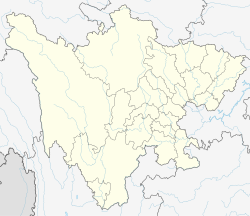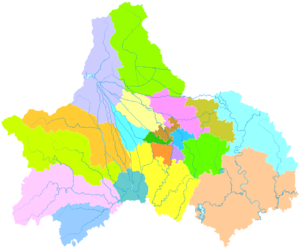Dujiangyan
都江堰市 | |||||||||||||||||||||||||||||||||||||||||||||||||||||||||||||||
|---|---|---|---|---|---|---|---|---|---|---|---|---|---|---|---|---|---|---|---|---|---|---|---|---|---|---|---|---|---|---|---|---|---|---|---|---|---|---|---|---|---|---|---|---|---|---|---|---|---|---|---|---|---|---|---|---|---|---|---|---|---|---|---|
 Puzhao Temple in Dujiangyan | |||||||||||||||||||||||||||||||||||||||||||||||||||||||||||||||
| Etymology: Dujiangyan | |||||||||||||||||||||||||||||||||||||||||||||||||||||||||||||||
 Location of Dujiangyan in Sichuan | |||||||||||||||||||||||||||||||||||||||||||||||||||||||||||||||
| Coordinates (Dujiangyan Government): 30°59′17″N 103°38′49″E / 30.988°N 103.647°E | |||||||||||||||||||||||||||||||||||||||||||||||||||||||||||||||
| Country | China | ||||||||||||||||||||||||||||||||||||||||||||||||||||||||||||||
| Province | Sichuan | ||||||||||||||||||||||||||||||||||||||||||||||||||||||||||||||
| Sub-provincial city | Chengdu | ||||||||||||||||||||||||||||||||||||||||||||||||||||||||||||||
| Municipal seat | Guankou Subdistrict | ||||||||||||||||||||||||||||||||||||||||||||||||||||||||||||||
| Area | |||||||||||||||||||||||||||||||||||||||||||||||||||||||||||||||
| • Total | 1,208 km2 (466 sq mi) | ||||||||||||||||||||||||||||||||||||||||||||||||||||||||||||||
| Population (2020)
[1] | |||||||||||||||||||||||||||||||||||||||||||||||||||||||||||||||
| • Total | 710,056 | ||||||||||||||||||||||||||||||||||||||||||||||||||||||||||||||
| • Density | 545/km2 (1,410/sq mi) | ||||||||||||||||||||||||||||||||||||||||||||||||||||||||||||||
| Time zone | UTC+8 ( China Standard) | ||||||||||||||||||||||||||||||||||||||||||||||||||||||||||||||
| Postal code | 6118XX | ||||||||||||||||||||||||||||||||||||||||||||||||||||||||||||||
| Chengdu district map |
| ||||||||||||||||||||||||||||||||||||||||||||||||||||||||||||||
| Website |
www | ||||||||||||||||||||||||||||||||||||||||||||||||||||||||||||||
| Dujiangyan | |||||||||
|---|---|---|---|---|---|---|---|---|---|
| Chinese | 都江堰 | ||||||||
| Postal | Tukiangyen Kwanhsien (until 1988) | ||||||||
| |||||||||
| Guanxian | |||||||||
|---|---|---|---|---|---|---|---|---|---|
| Traditional Chinese | 灌縣 | ||||||||
| Simplified Chinese | 灌县 | ||||||||
| Postal | Kwanhsien | ||||||||
| |||||||||
Dujiangyan ( Chinese: 都江堰; pinyin: Dūjiāngyàn) is a county-level city of Sichuan Province, Southwest China, it is under the administration of the prefecture-level city of Chengdu. Its north-west region forms a border with southern Ngawa Tibetan and Qiang Autonomous Prefecture. It has an area of 1,208 km2 (466 sq mi) and had a population of 710,056 in 2020. [1]
Dujiangyan was formerly a county named Guanxian or Guan County (灌县; 'irrigation" county'). The county became a county-level city in 1988 and was renamed after the Dujiangyan Irrigation System, in the city's northwest, famous for providing Chengdu with water for over two millennia, since around 250 BC.
History
Around 250 BC during the Warring States period, Li Bing, a governor of Shu (present Sichuan Province) in the Qin state with his son directed the construction of Dujiangyan. Li Bing gave up the old ways of dam building, which were simply directed at flood control, employing a new method of channeling and dividing the water of the Min River. He accomplished this by separating the project into two main parts: the headwork and the irrigation system. The whole system has functioned for 2,000 years, preventing floods and providing substantial irrigation and facilitating shipping and wood drifting. It has contributed greatly to the richness of Chengdu Plain with its reputation as "The Land of Abundance".[ citation needed]
On 12 May 2008, the city was the closest to the epicenter of the 2008 Sichuan earthquake and the city suffered severe damage. Xinjian Primary School, Juyuan Middle School, and Xiang'e Middle School collapsed in the earthquake. [2] [3] [4]
Climate
Dujiangyan has a monsoon-influenced humid subtropical climate ( Köppen Cwa) with cool, dry winters and hot, very wet summers.
| Climate data for Dujiangyan, elevation 689 m (2,260 ft), (1991–2020 normals, extremes 1971–2010) | |||||||||||||
|---|---|---|---|---|---|---|---|---|---|---|---|---|---|
| Month | Jan | Feb | Mar | Apr | May | Jun | Jul | Aug | Sep | Oct | Nov | Dec | Year |
| Record high °C (°F) | 17.9 (64.2) |
21.0 (69.8) |
29.7 (85.5) |
31.3 (88.3) |
33.4 (92.1) |
34.7 (94.5) |
35.5 (95.9) |
35.0 (95.0) |
34.2 (93.6) |
28.2 (82.8) |
24.8 (76.6) |
17.7 (63.9) |
35.5 (95.9) |
| Mean daily maximum °C (°F) | 8.5 (47.3) |
11.1 (52.0) |
15.7 (60.3) |
21.3 (70.3) |
25.1 (77.2) |
27.4 (81.3) |
29.4 (84.9) |
29.1 (84.4) |
24.7 (76.5) |
19.7 (67.5) |
15.2 (59.4) |
10.0 (50.0) |
19.8 (67.6) |
| Daily mean °C (°F) | 5.2 (41.4) |
7.5 (45.5) |
11.6 (52.9) |
16.7 (62.1) |
20.6 (69.1) |
23.3 (73.9) |
25.2 (77.4) |
24.8 (76.6) |
21.0 (69.8) |
16.4 (61.5) |
11.8 (53.2) |
6.6 (43.9) |
15.9 (60.6) |
| Mean daily minimum °C (°F) | 2.7 (36.9) |
4.9 (40.8) |
8.4 (47.1) |
13.1 (55.6) |
17.0 (62.6) |
20.0 (68.0) |
21.9 (71.4) |
21.6 (70.9) |
18.5 (65.3) |
14.2 (57.6) |
9.5 (49.1) |
4.2 (39.6) |
13.0 (55.4) |
| Record low °C (°F) | −5.0 (23.0) |
−3.6 (25.5) |
−2.9 (26.8) |
0.4 (32.7) |
6.4 (43.5) |
13.1 (55.6) |
15.6 (60.1) |
15.0 (59.0) |
11.9 (53.4) |
2.9 (37.2) |
−0.2 (31.6) |
−7.1 (19.2) |
−7.1 (19.2) |
| Average precipitation mm (inches) | 15.3 (0.60) |
20.2 (0.80) |
41.9 (1.65) |
65.7 (2.59) |
91.3 (3.59) |
115.8 (4.56) |
266.5 (10.49) |
273.4 (10.76) |
161.2 (6.35) |
71.3 (2.81) |
30.9 (1.22) |
13.0 (0.51) |
1,166.5 (45.93) |
| Average precipitation days (≥ 0.1 mm) | 11.0 | 12.0 | 14.2 | 15.2 | 16.2 | 16.7 | 18.0 | 17.2 | 19.3 | 19.5 | 11.5 | 9.1 | 179.9 |
| Average snowy days | 3.2 | 1.3 | 0.1 | 0 | 0 | 0 | 0 | 0 | 0 | 0 | 0.1 | 0.7 | 5.4 |
| Average relative humidity (%) | 80 | 79 | 76 | 74 | 71 | 75 | 78 | 79 | 83 | 84 | 82 | 81 | 79 |
| Mean monthly sunshine hours | 46.2 | 45.8 | 67.2 | 93.9 | 96.9 | 86.6 | 108.4 | 106.6 | 46.8 | 39.0 | 47.7 | 49.7 | 834.8 |
| Percent possible sunshine | 14 | 15 | 18 | 24 | 23 | 21 | 25 | 26 | 13 | 11 | 15 | 16 | 18 |
| Source 1: China Meteorological Administration [5] [6] | |||||||||||||
| Source 2: Weather China [7] | |||||||||||||
Administrative divisions
Dujiangyan has 6 subdistrict and 5 towns: [8]
- Kuiguangta Subdistrict 奎光塔街道
- Xingfu Subdistrict 幸福街道
- Guankou Subdistrict 灌口街道
- Yinxing Subdistrict 银杏街道
- Yutang Subdistrict 玉堂街道
- Puyang Subdistrict 蒲阳街道
- Juyuan Town 聚源镇
- Tianma Town 天马镇
- Shiyang Town 石羊镇
- Qingchengshan Town 青城山镇
- Longchi Town 龙池镇
Transport

See also
Notes
- ^ a b "成都市第七次全国人口普查公报(第二号)" [Seventh National Census of Chengdu (Bulletin No.2)] (PDF). Chengdu Municipal Statistics Bureau. 27 May 2021.
- ^ " Chinese Are Left to Ask Why Schools Crumbled." The New York Times.
- ^ " Provincial authority outlines school collapse reasons." China.org.
- ^ " Overwhelmed by death, Sichuan disinfects Archived 9 August 2017 at the Wayback Machine." Reuters India.
- ^ 中国气象数据网 – WeatherBk Data (in Simplified Chinese). China Meteorological Administration. Retrieved 13 April 2023.
- ^ 中国气象数据网 (in Simplified Chinese). China Meteorological Administration. Retrieved 13 April 2023.
- ^ 都江堰 – 气象数据 -中国天气网 (in Chinese). Weather China. Retrieved 22 November 2022.
- ^ 2023年统计用区划代码和城乡划分代码:都江堰市 (in Simplified Chinese). National Bureau of Statistics of China.
References
- "Dujiangyan". ChinaCulture. China: Ministry of Culture. 24 September 2003. Archived from the original on 10 December 2006.
External links
- Official website of Dujiangyan Government Archived 25 April 2020 at the Wayback Machine

